
- •Foreword
- •Preface
- •Key to Diagrams
- •Reading Pressure and Options
- •Reacting to Support the Breakout
- •Breakout Plays
- •Control Breakouts
- •Counters
- •Regroups
- •Dump-In Entries
- •Mid-Ice Entries
- •Wide-Lane Drives
- •The Funnel
- •Two-on-One Attacks
- •Two-on-Two Attacks
- •Three-on-Two Attacks
- •Offsides
- •Activating Defense Into Offensive Zone Entries
- •Cycling
- •Playing Behind the Net
- •Stretching the Zone: Low-High Plays
- •Activating Defense in the Offensive Zone
- •Attack Zone Plays
- •Power-Play Breakouts
- •Gaining and Maintaining Possession off the Entry
- •Zone Setup
- •Five-on-Three Power Play
- •Four-on-Three Power Play
- •Forechecking Systems
- •Neutral Zone Forechecking
- •Neutral Zone Forechecking Systems
- •Neutral Zone Backchecking
- •Neutral Zone Backchecking Systems
- •Handling Defensive Zone Entries
- •Defensive Zone Systems
- •Situational Guidelines for Defensive Zone Coverag
- •Face-Offs and Penalty Kills
- •Forechecking and Penalty Kills
- •Pressuring the Entry
- •Defensive Zone Play
- •Three-on-Five Penalty Kill
- •Three-on-Four Penalty Kill
- •Offensive Zone Face-Offs
- •Neutral Zone Face-Offs
- •Defensive Zone Face-Offs
- •Power-Play Face-Offs
- •Penalty-Kill Face-Offs
- •Special Face-Off Situations
- •Managing Staff
- •Dealing With Officials
- •Adjusting Your Playing Strategy
- •Managing Lines
- •Line Changes
- •Handling the Moment
- •Index
- •About the Authors
Penalty-Kill Face-Offs
Since the face-off is such an important part of the penaltykill, it was covered in depth in chapter 10 on penalty kills. As mentioned in that chapter, it is very important to gain possession on special teams. Penalty-killing units want to frustrate the power play by making them go back down the ice 200 feet (61 m) to get the puck and start a breakout. More face-off options are presented in chapter 10 (pages 145-148), but here are two common strategies to use after winning draws in the defensive zone.
■ CORNER BUMP
In this situation, when C wins the draw LW drops down to the wide corner (figure 11.33). D1 bumps the puck over to LW, who clears the puck. D2 should screen the opponent’s inside winger to provide time for LW to get the puck and shoot it down the ice.
Figure 11.33

■ RIM CLEAR
It is best if the Ds switch sides—this will give the boards-side defenseman the ability to shoot the puck around the boards hard (figure 11.34). C tries to win the draw back to the corner or tie up his opponent and allow the puck to sit in behind. D1 (who is now a left shot) moves in quickly and rims the puck hard on the boards or the glass.
Figure 11.34
Special Face-Off Situations
In this section, we cover face-off strategies for four-on-four play and late-game pulled goaltender situations. Although there aren’t as many four-on-four face-offs in a game, it is important that the team be prepared—especially with overtime at most levels using four-on-four play to decide the game. Pulled goaltender situations also don’t happen often, but they are very critical for getting that tying goal.
Four-on-Four Face-Offs
We outline one offensive and two defensive alignments for four-on-four situations. On lost draws, coverage is much more difficult when teams are four on four because the center is often tied up taking the face-off and can’t get out to the opposing defenseman. Having the D take the draw is a strategy which should be considered.
■ FOUR ACROSS
The center tries to win the draw back to D1 or D2. If the draw is lost F2 must resist the temptation to go out to the boardside defenseman and stay in the slot (figure 11.35). Center battles to get out to pressure the strong side defense. If the puck is passed D-D then F2 moves out in the shooting lane. D1 picks up the opposing center. D2 takes the inside forward. This alignment is the more traditional one used in a teams defensive zone but it does result in problems for the center getting out quickly.
Figure 11.35
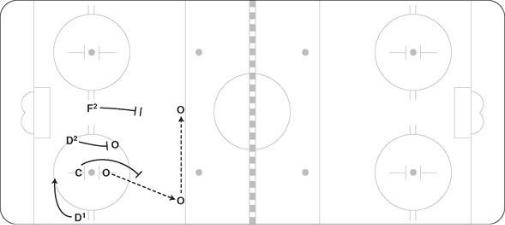
■ D TAKES THE DRAW
This sound defensive alignment is not commonly used because it is one where the defense has to practice taking faceoffs. Have D1 take the draw and D2 line up beside the other team’s remaining forward (figure 11.36). On a lost draw, D1 and D2 take the other team’s forwards, and F1 and F2 go to the opposing defensemen. If the opposition lines up with three up on the draw, then D1 should look at shooting the puck through for F1 and F2 to go two on one.
Figure 11.36
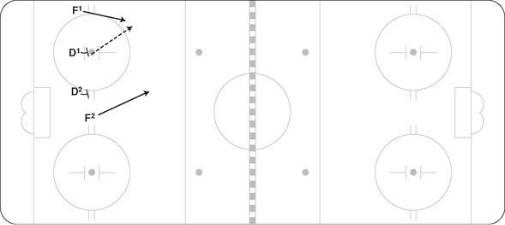
■ BOARDS-SIDE ROLL
After winning the face-off in four-on-four situations, teams should make it difficult for the opposition by having a wide option. C takes the draw and wins it back to D1 on the boards (figure 11.37). D1 lines up a few steps back from the hash marks on the boards side. D1 has the option to shoot with F2 at the net or pass to D2 for a one-timer shot. D1 and D2 should switch sides, making it easier for them to shoot.
Figure 11.37


Pulled Goaltender
This is an exciting time of the game when a team pulls the goaltender for an extra attacker. Usually it is in the last minute of the game, and the strategy should be to create a chance right off the draw. The play doesn’t have to be complicated, but all players need to know what option is being executed. Here are a few strategies.
■ INSIDE-OUT PLAY
C wins the draw or leaves the puck in behind him. LW, C, and EX (extra forward) drive the net (figure 11.38). RW swings to the outside and takes the puck or receives it from D1. C pops out into the slot. RW looks to make a play to C, back to D1, to the front of the net, or to D2 on the back side.
Figure 11.38
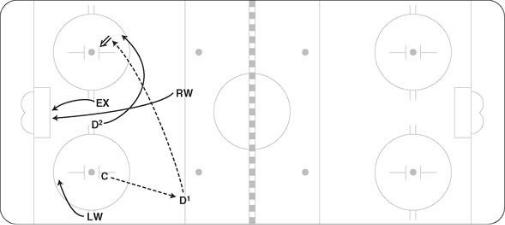
■ D SLIDE PLAY
RW is back for the draw, with D2 up on the inside of the circle (figure 11.39). C draws the puck back to D1. RW goes to the net. EX (extra forward) goes to the net. D2 slides out and is ready for a one-timer shot (in this example, D2 is a left shot). D1 may shoot at the net or pass to D2 for a quick shot.
Figure 11.39
■ DOUBLE OPTION
Two forwards line up on the inside (figure 11.40), and one is on the boards (this player must be a left shot). C can draw the puck to the boards so that EX (extra forward) can take a quick shot or the center can tap the puck ahead and make a quick play to the net for LW and RW.
Figure 11.40
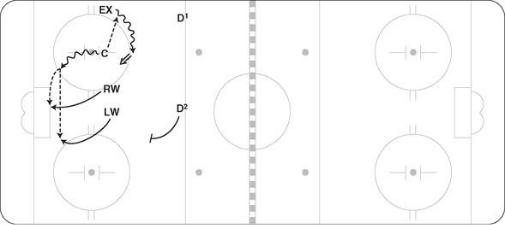
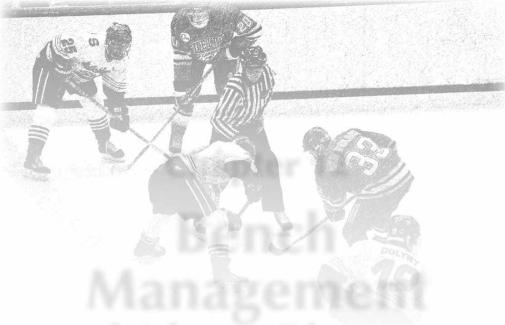
Chapter 12
Bench Management and Line Changes
It has often been said that bench management is the one skill that separates the top coaches from those who are average or below average. Scotty Bowman, recognized as one of the greatest hockey coaches ever, was well respected by opposing players and coaches for his ability behind was well respected by opposing players and coaches for his ability behind the bench. What are the inherent skills in a coach who can manage the bench like Scotty Bowman?
The great coaches and players all have in common the ability to “see the ice.” They have the unique ability to slow the game down —they see things at a controlled pace and rarely miss anything that happens on the ice. After the game is over (and for some coaches, even years after the game was played), they can recall certain moments clearly. To see the ice with the best, a coach must focus on the game at all times. Don’t get distracted by what is happening on the bench or irrelevant things happening on the ice. Stay in emotional control. Stay in the moment. You should always be looking for the one adjustment that will give your team the advantage.
A major aspect of being a great coach is being prepared before the game starts. Know everything you can about the opponent. Who are their top players, who are their weaker players, and what are the tendencies of both? Statistically, is there anything revealing as far as team or individual tendencies? What is their coach like? Does he match lines or shorten his bench? What is his trademark style of play? For example, if you know the opposing coach likes to match lines, then you try to make it hard for him to get the right match. Change on the fly, switch the rotation of your lines (instead of 1-2-3, go 1-2-1-3), or move your top players from line to line. These are all ways to get away from a strong match.
It is important to study the opponent thoroughly; watch them on video if possible, or seek out people who have watched them play. Have a friend or staff member pre-scout them. Ultimately, you want to provide your team with five or six key points based on what you know about the other team. Players will realize that their opportunity for success lies in their ability to execute these points.
